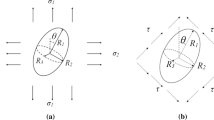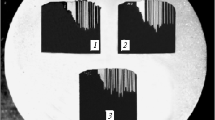Abstract
An elastic-plastic finite element method (FEM) is used to analyze the stress distributions ahead of crack tips for three types of COD specimens with different precracked depth a/W and height W of a low alloy steel, and the tensile and COD tests are carried out at various temperatures. By accurately measuring the distances of the cleavage initiation sites from the blunted crack tips, the local cleavage fracture stresses σf are measured. With increasing precrack depth a/W, specimen height W and test temperatures in a certain range, it was found that the σf essentially does not change. The σf is a steady inherent parameter of the material whose value is independent of the precracked specimen geometry.
Similar content being viewed by others
REFERENCES
Anderson, T.L. and Dodds, R.H. (1991). Specimen size requirements for fracture toughness testing in the ductilebrittle transition region. J. Testing and Evaluation 19, 123–134.
Beremin, F.M. (1983). A local criterion for cleavage fracture of a nuclear pressure vessel steel. Metallurgical Transaction 14A, 2277–2287.
Bowen, P. and Knott, J.F. (1986). Size effect on the microscopic cleavage fracture stress, σf, in martensitic microstructures. Metallurgical Transaction 17A, 231–241.
Chen, J.H. and Wang, G.Z. (1998). On scattering measured values of fracture toughness parameters. International Journal of Fracture 94, 33–49.
Chen, J.H. and Yan, C. (1988). Fracture behavior of C-Mn steel multipass MMA weld metals at-60 °C in Charpy v testing. Material Science and Technology 4, 732–739.
Chen, J.H. and Yan, C. (1992). A comparison of toughness of C-Mn weld steel with different grain size. Metallurgical Transaction 23A, 2549–2556.
Chen, J.H., Wang, G.Z. and Ma, H. (1990). Fracture behavior of C-Mn steel and weld metal in notched and precracked specimens. Part II. Micromechanism of fracture. Metallurgical Transaction 21A, 321–330.
Chen, J.H., Wang, G.Z., Wang, Z., Zhu, L. and Gao, Y.Y. (1991). Further study on the scattering of local fracture stress and allied toughness values. Metallurgical Transaction 22A, 2287–2296.
Chen, J.H., Zhu, L. and Ma, H. (1990). On the scattering of the local fracture stress. Acta Metallurgica et Materiali 38, 2527–2535.
Chen, J.H., Yan, C. and Sun, J. (1994). Further study on the mechanism of cleavage fracture at low temperatures. Acta Metallurgica 42, 251–261.
Chen, J.H., Hu, X.J. and Wang, G.Z. (1996). The local fracture stress as a fracture toughness parameter to characterize an heterogeneous weld zone. Fatigue and Fracture of Engineer Material and Structure 19, 68–80.
Chen, J.H., Wang, G.Z. and Wang, H.J. (1996). A statistical model for cleavage fracture of low alloy steel. Acta Mater. 44, 3979–3989.
Chen, J.H., Wang, G.Z., Yan, C., Ma, H. and Zhu, L. (1997a). Advances in the mechanism of cleavage fracture of low alloy steel at low temperature. Part III. Local fracture stress σf. International Journal of Fracture 83, 139–157.
Chen, J.H., Wang, G.Z., Yan, C., Ma, H. and Zhu, L. (1997b). Advances in the mechanism of cleavage fracture of low alloy steel at low temperature. Part II: Fracture model. International Journal of Fracture 83, 121–138.
Curry, D.A. (1980). Cleavage micromechanisms of crack extension in steel. Metal Science Aug.-Sept., 319–326.
Curry, D.A. and Knott, J.F. (1978). Effect of microstructure on cleavage fracture stress in steel. Material Science Nov, 511–514.
Dodds, R.H., Anderson, T.L. and Kirk, M.T. (1991). A framework to correlate a/W ratio effects on elastic-plastic fracture toughness (Jc). International Journal of Fracture 48, 1–22.
Kavishe, F.R.L. and Baker, T.J. (1986). Micromechanism of cleavage fracture in fully pearlitic steels. Material Science and Technology 2, 583.
Kirk, M.T., Koppenhoefer, K.C. and Sih, C.F. (1993). Effect of constraint on specimen dimensions needed to obtain structurally relevant toughness measures. Constraint Effects in Fracture, ASTM STP 1171 (Edited by E.M. Hackett, K.H. Schwalbe, and R.H. Dodds), American Society for Testing and Materials, Philadelphia, 79–103.
Knott, J.F. (1966). Some effects of hydrostatic tension on the fracture behavior of mild steel. Journal of the Iron and Steel Institute 204, 104–111.
Lewandowski, J.J. and Thompson, A.W. (1986a). Effects of the prior austenite grain size on the ductility of fully pearlitic eutectoid steel. Metallurgical Transactions 17A, 461–472.
Lewandowski, J.J. and Thompson, A.W. (1986b). Microstructiral effects on the cleavage fracture stress of fully pearlitic eutectoid steel. Metallurgical Transactions 17A, 1769–1786.
Lewandowski, J.J. and Thompson, A.W. (1987). Micromechanisms of cleavage fracture in fully pearlitic microstructure. Acta Metallurgica 35, 1453–1461.
Lin, T., Evans, A.G. and Ritchie, R.O. (1986). Statistical analysis of cleavage fracture ahead of sharp crack and rounded notches. Acta Metallurgica 34, 2250.
Lin, T. and Ritchie, R.O. (1988). On the effect of sampling volume on the microscopic cleavage fracture stress. Engineer Fracture Mechanics 29, 697–703.
McMeeking, R.M. (1977). Finite deformation analysis of crack-tip opening in elastic-plastic materials and implications for fracture. Journal of Mechanics and Physics of Solids 25, 357–381.
Pineau, A. (1981). Review of fracture micromechanism and a local approach to predicting crack resistance in low strength steels, Proc. ICF5, Cannes, France, Pergamon Press, Oxford, 553.
Ritchie, R. O. and Thompson, A. W. (1985). On macroscopic and microscopic analyses for crack initiation and crack growth toughness in ductile alloys. Metallurgical Transaction 16A, 233–248.
Ritchie, R.O., Knott, J.F. and Rice, J.R. (1973). On the relationship between critical tensile stress and fracture toughness in mild steel. Journal of Mechanics and Physics of Solids 21, 395–410.
Ritchie, R.O., Francis, Benjamin and Server, W.L. (1976). Evaluation of toughness in ALSL 4340 alloy steel austenitized at low and high temperatures. Metallurgical Transaction 7A, 831–838.
Ritchie, R.O., Server, W.L. and Wullaert, R.A. (1979). Critical fracture stress and fracture strain models for the prediction of lower and upper shelf toughness in nuclear pressure vessel steels. Metallurgical Transaction 10A, 1557–1570.
Ruggieri, C. and Dodds, R.H. (1996). A transferability model for brittle fracture including constraint and ductile tearing effects, a probabilistic approach. International Journal of Fracture 79, 309–340.
Samant, A.V. and Lewandowski, J.J. (1997). Effects of test temperature, grain size, and alloy additions on the cleavage fracture stress of polycrystalline niobium. Metallurgical and Materials Transaction 28A, 389–399.
Samant, A.V. and Lewandowski, J.J. (1997). Effects of test temperature, grain size, and alloy additions on the lowtemperature fracture toughness of polycrystalline niobium. Metallurgical and Materials Transaction 28A, 2297–2307.
Sorem, W.A., Dodds, R.H. and Rolfe, S.T. (1991). Effects of crack depth on elastic-plastic fracture toughness. International Journal of Fracture 47, 105–126.
Tetelman, A.S., Wilshaw, T.R. and Jr Rau, C.A. (1968). The critical tensile stress criterion for cleavage. International Journal of Fracture 4, 147–157.
Wang, G.Z. and Chen, J.H. (1998). Cleavage fracture criterion of low ally steel and weld metal in notched specimens. International Journal of Fracture 89, 269–284.
Wang, G.Z. and Chen, J.H. (2001). On locations initiating cleavage fracture in precracked specimens of low alloy steel and weld metal. International Journal of Fracture 108, 235–250.
Wang, G.Z., Wang, H.J. and Chen, J.H. (1999). Effects of notch geometry on the local cleavage fracture stress σ f. Fatigue and Fracture of Engineer Material and Structure 22, 849–858.
Yan, C., Chen, J.H., Sun, J. and Wang, Z. (1993). Critical assessment of the local cleavage stress in notched specimens of C-Mn steel. Metallurgical Transaction 24A, 1381–1389.
Author information
Authors and Affiliations
Rights and permissions
About this article
Cite this article
Wang, G., Liu, G. & Chen, J. Effects of precracked specimen geometry on local cleavage fracture stress σf of low alloy steel. International Journal of Fracture 112, 183–196 (2001). https://doi.org/10.1023/A:1013322223233
Issue Date:
DOI: https://doi.org/10.1023/A:1013322223233




